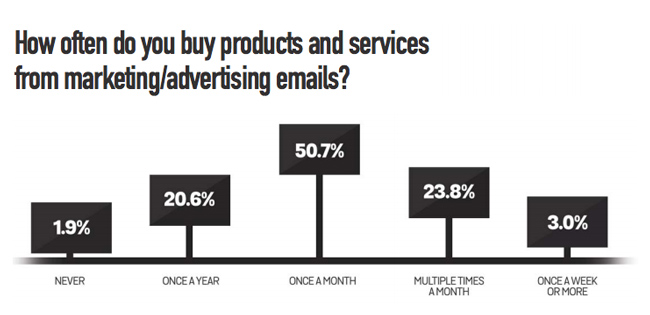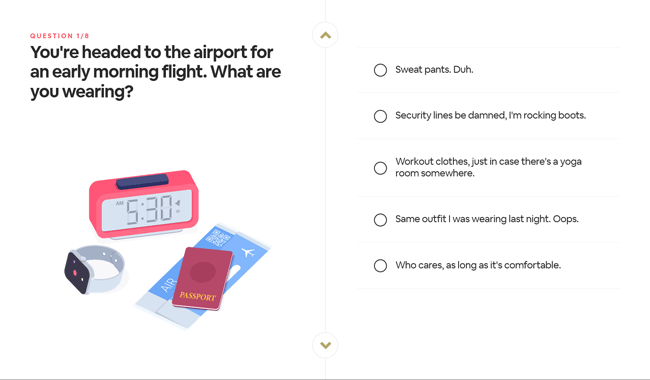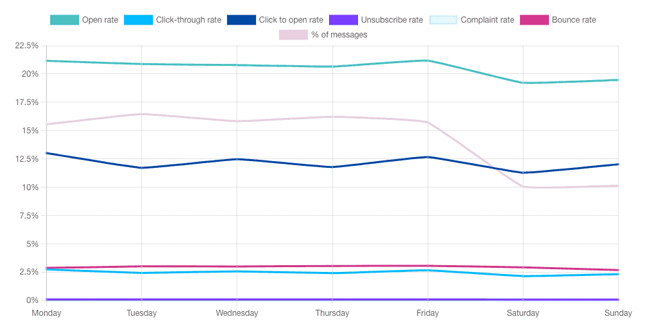You’re heading to a meeting with your stakeholders to present the results of last quarter’s email campaign, for which you took the lead.
There’s a spring in your step as you approach the boardroom, and a satisfied smile adorns your face as you take your seat.
Your eyes lock with your marketing manager, and their expression mirrors your own as they welcome you to share your insights.
As you paint a vivid picture for your stakeholders of the resounding success of the executed email marketing campaigns, you notice their undivided attention, actively asking questions, and commending you for a job well done.
Seizing the opportunity, you confidently present your fresh ideas for the upcoming quarter and request an increased budget. Without hesitation, they agree, and there’s even talk of a generous Christmas bonus coming your way.
What if we told you that this could be your reality?
All you need to do is to implement the invaluable insights from our digital marketing materials and textbooks, which are built around design thinking fundamentals.
These resources will ensure that your brand effectively connects with your audience across email marketing channels.
Today, we’re going to take a look at how you can generate high-quality leads for your email list and nurture them into loyal customers. We’ll also cover:
- Real-world examples of companies that implement design thinking into their email marketing strategies
- A range of unique email lead capture strategies proven to generate high-quality leads
- How you can leverage your email list to increase social media engagement
Without further ado, let’s dive straight into the lead generation techniques and nurturing that will set you on the path to unparalleled success.
1 – Implement Design Thinking, Email Lead Capture Strategies

Source: salecycle.com
Is email marketing dead?
Absolutely not!
In fact, according to a research study conducted by SaleCycle in 2022, 50% of customers make monthly purchases from marketing emails every month.
However, it’s important to note that the average person spends a mere 10 seconds glancing at brand emails, as highlighted by a study from Statista. This means you have just a brief opportunity to captivate their attention.
Enter brilliant marketers who harness the power of design thinking. They understand the importance of increasing customer dwell time by curating content that stops readers in their tracks and persuades them to take desirable actions.
Through the application of design thinking principles, marketers can craft impactful and personalized email marketing campaigns that deeply resonate with their target audience. The result? Heightened engagement and conversion rates.
It’s crucial to implement the following effective lead capture strategies, all rooted in this human-centric approach:
Interactive Games and Quizzes

Source: airbnb.com
To capture the attention of your target audience and encourage their active participation, create interactive and engaging quizzes or assessments with a format that makes the experience enjoyable and interactive. This will increase the likelihood of users completing the assessment.
To ensure that the quiz format is enjoyable and interactive, we highly recommend conducting thorough research to understand your target audience’s pain points, motivations, and preferences related to your company’s product or service.
You can accomplish this by employing a combination of qualitative and quantitative research methods, such as surveys, interviews, social listening, and data analysis, to gain insights into their needs and behaviors.
For example, Airbnb created an interactive and fun quiz called Airbnb Trip Matcher to help its users choose an ideal travel destination based on their personality.
Airbnb crafted the quiz by asking customers easy questions with amusing multiple-choice answers. This approach intrigued and sparked curiosity in their customers, making them more inclined to provide their email addresses in order to receive the quiz’s final results.
By providing their email addresses, users gain access to a valuable resource that helps them plan their ideal vacation, reinforcing their connection with Airbnb as a trusted travel partner.
Airbnb can then utilize the collected email addresses to send targeted emails to users, offering them relevant accommodation options, special discounts, or tailored travel tips based on their quiz responses.
Expert Tip: Boost user engagement by incorporating gamification elements, such as a leaderboard or rewards, into your quizzes.
Valuable Content and Gated Resources
One of the biggest perks of understanding your target audience’s interests and pain points is that you’re then able to create highly relevant and engaging content, such as e-books, guides, and industry reports.
By adopting a user-centered approach, you’re able to curate content that provides valuable insights, practical solutions, and helpful information to address identified challenges.
Once you’ve created a valuable lead magnet, determine the most effective channels for reaching your target audience. Consider their preferences, behaviors, and where they’re most likely to discover and engage with your content.
For example, your research indicates that your ideal customer loves to read long-form copy. In this case, you can create a blog post that’s Search Engine Optimized (SEO) and run a search ad campaign to attract them to your website.
OnDigitalMarketing has a beginner’s textbook with actionable, evidence-based SEO optimization strategies that you can employ to rank high on search engine results pages (SERPs).
Ensure you utilize the design thinking approach of empathy to understand your users’ needs and craft a compelling message and visuals for your blog post. These should highlight the value and benefits of accessing the gated content to entice users to take action.
Requiring users to provide their email addresses to access gated content enables lead capture, allowing you to build a database of potential customers.
By delivering additional relevant content and nurturing leads via email marketing campaigns, you can build relationships, strengthen brand affinity, and guide leads through the user journey, ultimately driving business growth.
Webinars or Online Events

Fun Fact: Webinars are proven to be incredibly effective in generating high-quality leads for B2B companies.
This finding is supported by a research trial conducted by GoTo 1, which analyzed 250,000 webinars. The study revealed that 73% of B2B companies consider webinars and online events as the best means of acquiring prospects with a higher likelihood of converting.
Here are a few probable reasons why webinars are so effective in lead generation:
- Niche offering: Webinars and online events provide the opportunity to attract a highly targeted audience. By choosing a specific topic or theme relevant to your niche, you can attract individuals who are genuinely interested in your industry or offerings.
This targeted audience is more inclined to provide their email addresses, resulting in high-quality leads. - Interactive environment: Additionally, a webinar creates an interactive environment where participants can engage with your content and interact with the host or speakers.
Seeing a friendly human face representing your brand fosters a sense of connection and involvement, making attendees more receptive to providing their email addresses to continue the conversation or access additional resources. - Timeless content: You can conveniently record a webinar or online event and offer it as on-demand content, allowing individuals who couldn’t attend the live session to access the information.
Repurposed content can be used for lead generation by requiring email registration to access the recorded webinar or event. Not only will this benefit those who missed the live event, but also any future prospects whose user journey leads them to your website.
OnDigitalMarketing has years of experience leveraging tactical and real-world education from the trenches of eCommerce and digital marketing to help you understand your users and delight them across SEO, social media, paid, and email outlets.
Our methods have generated a whopping $350 million in revenue for our clients and are taught across three undergraduate universities. We would love to help you become a success too.
2 – Build Rapport & Trust Over Time by Nurturing Email Leads
When your customers honor you by filling out opt-in forms and joining your email list, it’s your responsibility as a marketer to make their experience with your brand superb. You can do so by fulfilling all of the promises you made to them.
Although it may be tempting, don’t bombard the customer with too many emails—this will land you in the dreaded spam folder, potentially damaging your sender reputation.
When email service providers (ESPs) and internet service providers (ISPs) notice you doing this, they flag your domain as untrustworthy, damaging your deliverability rates in the future.
Instead of spamming your customers with excessive and annoying emails, consider thinking about nurturing your email leads in the following manner:
Segment Your Email List
First of all, you need to cut through the noise by segmenting your list according to where each subscriber is in terms of their user journey, behavior, interests, and preferences in order to deliver highly relevant and personalized content.
A prime example of a company that excels in implementing this email marketing strategy is Spotify. They leverage data from user interactions and listening preferences to personalize their emails.
Subscribers receive emails with recommended playlists, new music releases from their favorite genres and artists, and concert notifications for artists they’ve shown interest in.
For instance, in a recent email campaign, the music platform prompted its users to participate in a competition for a chance to win $2,000 to spend on concerts held by Universal Music Group artists in 2023.
Because their list is segmented, they can send this email out to listeners who frequent these artists’ music, only targeting highly relevant listeners. As a result, they provide value to their subscribers, increase user engagement, and ultimately foster customer loyalty.
The table below can be used as a guide to help personalize the email content for each prospect for higher conversion rates:
| Segment Name | Behavior/Interests | Email Content Objectives | Metrics For Evaluation |
| Genre lovers | Preference for specific music | Recommend playlists based on genre preference | Click-through rate |
| Artist fans | Artists they have shown interest in | Notify about new music releases from favorite artists | Open rate, conversion rate |
| Concert-goers | Interest in attending concerts | Promote upcoming concerts and ticket availability | Ticket sales, RSVP rate |
| Competition | Participated in a competition | Announce competition winners and future promotions | Social media engagement, participation |
| New subscribers | Recently joined the mailing list | Welcome email with introduction and benefits | Open rate, subscription retention |
Create a Series of Automated Emails
We highly recommend designing a series of well-crafted and informative emails that offer valuable content, insights, tips, or exclusive offers to your subscribers.
Each email in the series should serve a specific purpose and provide a unique value proposition to engage and captivate the attention of the recipients.
It’s important to strike a balance and avoid overwhelming your email list with excessive messages that might lead to annoyance or disengagement.
For example, Coschedule suggests sending out emails two or three times a week, preferably on Tuesday, Wednesday, and Thursday between 10 a.m. and 3 p.m. These time frames tend to yield higher open rates and ultimately contribute to improved conversion rates.
GetResponse’s Michal Leszczynski finds that “Email engagement is usually quite stable throughout the day and goes in-line with the typical business hours. There’s little difference in terms of engagement between individual weekdays.”

By delivering consistent value through these automated emails, you can establish trust, showcase expertise, and ensure that your brand remains top-of-mind for your customers.
To illustrate, let’s consider Airbnb’s email sequence. Once a user signs up for their email list, they receive a series of personalized and value-driven emails.
The initial email might provide destination recommendations based on the user’s location or preferences. Subsequent emails may feature travel tips, exclusive discounts on accommodations, or highlights of unique experiences available through Airbnb.
The desired outcome is to keep the Airbnb brand in the minds of subscribers, provide them with relevant and engaging content, and ultimately encourage them to book accommodations or experiences through the platform.
Leverage Social Media to Foster Engagement
Your email list consists of individuals who’ve already shown interest in your brand or products by subscribing.
Consequently, by promoting your social media channels to this audience, you can extend your reach and engage with them on multiple platforms.
This not only increases your brand’s visibility, but also allows you to tap into their networks, potentially attracting new followers and customers through social media engagement, shares, and interactions.
Moreover, by fostering conversations, responding to comments, and encouraging user-generated content, aspiring online marketers can create a sense of community and strengthen their relationships with their email leads.
For example, Nike’s marketers encourage their subscribers to follow their social media accounts, where they share inspiring stories, athlete collaborations, workout tips, and product updates.
The sportswear brand actively engages with its followers, responds to comments, and even runs campaigns that encourage user-generated content, such as sharing photos and videos of customers using their Nike products.
This strategy helps build a strong connection with their audience, increases brand loyalty, and drives conversions by keeping Nike top-of-mind when consumers are ready to make a purchase.
Bonus Tip: Consistently provide value to your email subscribers by offering exclusive content, promotions, and resources in your emails to keep them engaged and loyal over time.
Build Your List, Nurture Your Leads, and Reap the Benefits
Successful list building relies on two key aspects: generating high-quality leads and nurturing them into loyal customers.
OnDigitalMarketing has come up with a powerful framework that digital marketers and entrepreneurs can utilize to succeed in these two areas, design thinking.
By taking a step back and considering things from the customer’s point of view, you’re able to empathize and understand their needs, preferences, and motivations, allowing you to create compelling campaigns that resonate with your audience and drive desired actions.
Our team comprises driven and experienced experts who are dedicated to helping you craft effective digital campaigns that deliver tangible business results.
With our proven methods, we’ve generated an impressive $350 million in revenue for our clients, showcasing the effectiveness of our strategies.
To receive access to exclusive content, worksheets, upcoming courses, and insider tips, be sure to sign up for our email newsletter today.
